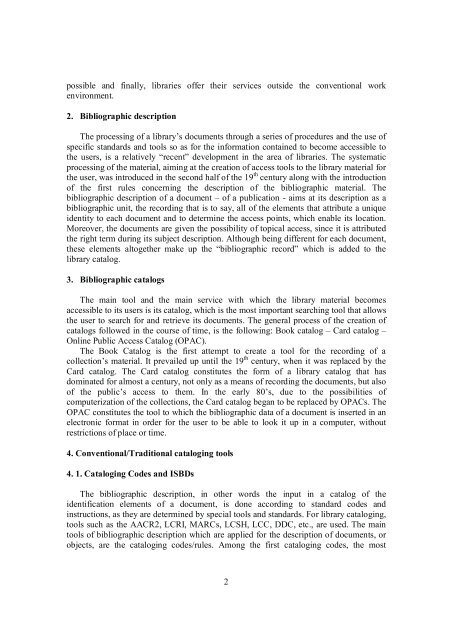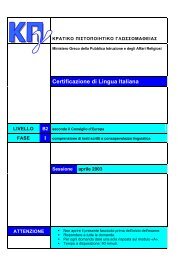Cataloging conventional and digital objects - Digital Library Logo
Cataloging conventional and digital objects - Digital Library Logo
Cataloging conventional and digital objects - Digital Library Logo
You also want an ePaper? Increase the reach of your titles
YUMPU automatically turns print PDFs into web optimized ePapers that Google loves.
possible <strong>and</strong> finally, libraries offer their services outside the <strong>conventional</strong> work<br />
environment.<br />
2. Bibliographic description<br />
The processing of a library’s documents through a series of procedures <strong>and</strong> the use of<br />
specific st<strong>and</strong>ards <strong>and</strong> tools so as for the information contained to become accessible to<br />
the users, is a relatively “recent” development in the area of libraries. The systematic<br />
processing of the material, aiming at the creation of access tools to the library material for<br />
the user, was introduced in the second half of the 19 th century along with the introduction<br />
of the first rules concerning the description of the bibliographic material. The<br />
bibliographic description of a document – of a publication - aims at its description as a<br />
bibliographic unit, the recording that is to say, all of the elements that attribute a unique<br />
identity to each document <strong>and</strong> to determine the access points, which enable its location.<br />
Moreover, the documents are given the possibility of topical access, since it is attributed<br />
the right term during its subject description. Although being different for each document,<br />
these elements altogether make up the “bibliographic record” which is added to the<br />
library catalog.<br />
3. Bibliographic catalogs<br />
The main tool <strong>and</strong> the main service with which the library material becomes<br />
accessible to its users is its catalog, which is the most important searching tool that allows<br />
the user to search for <strong>and</strong> retrieve its documents. The general process of the creation of<br />
catalogs followed in the course of time, is the following: Book catalog – Card catalog –<br />
Online Public Access Catalog (OPAC).<br />
The Book Catalog is the first attempt to create a tool for the recording of a<br />
collection’s material. It prevailed up until the 19 th century, when it was replaced by the<br />
Card catalog. The Card catalog constitutes the form of a library catalog that has<br />
dominated for almost a century, not only as a means of recording the documents, but also<br />
of the public’s access to them. In the early 80’s, due to the possibilities of<br />
computerization of the collections, the Card catalog began to be replaced by OPACs. The<br />
OPAC constitutes the tool to which the bibliographic data of a document is inserted in an<br />
electronic format in order for the user to be able to look it up in a computer, without<br />
restrictions of place or time.<br />
4. Conventional/Traditional cataloging tools<br />
4. 1. <strong>Cataloging</strong> Codes <strong>and</strong> ISBDs<br />
The bibliographic description, in other words the input in a catalog of the<br />
identification elements of a document, is done according to st<strong>and</strong>ard codes <strong>and</strong><br />
instructions, as they are determined by special tools <strong>and</strong> st<strong>and</strong>ards. For library cataloging,<br />
tools such as the AACR2, LCRI, MARCs, LCSH, LCC, DDC, etc., are used. The main<br />
tools of bibliographic description which are applied for the description of documents, or<br />
<strong>objects</strong>, are the cataloging codes/rules. Among the first cataloging codes, the most<br />
2












